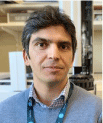Amine based liquid capture technology for direct air capture of CO2 – an overview on technology development
Ali Kiani A * , Mohamed H. Abdellah A , Ali Pourkhesalian A and Paul Feron BA
B

Dr Kiani has a background in chemical engineering and is a Lead Scientist in the area of direct air capture (DAC). He is currently leading the Carbon Dioxide Removal and Reuse (CDR2) team at CSIRO. Ali has contributed to a number of journal and conference publications, book chapters, patents, and technical reports in this area. He was a reviewer for the most recent International Energy Agency greenhouse gas reports on DAC. |

Dr Abdellah is a Research Scientist with a chemical engineering background who is working on the development of various innovative direct air capture processes. Mohamed is leading the development of new gas–liquid contactors for DAC in his current role. |

Dr Pourkhesalian has a mechanical engineering background and has contributed significantly to the engineering and operation aspects of direct air capture technology development. In his current role, Ali is involved in the commissioning and operation of lab and pilot scales plants. |

Dr Feron is a CSIRO Science Leader. In his current role as Science Leader for the Sustainable Carbon Technologies (SCT) Group, he oversees the transition of the Group’s emission and CO2-capture research expertise into the new domains of industrial CO2-capture, direct air capture and integrated CO2 utilisation. Paul represents Australian at the Executive Committee of the International Energy Agency Greenhouse Gas Technologies program and was a lead author for the IPCC special report on CO2 capture and storage. |
Abstract
The large-scale deployment of direct air capture (DAC) technologies is essential to meet the global target of limiting temperature increase to below 2°C. Amine-based liquid capture technology, as the leading method for point-source CO2 capture, holds promise as a low-cost and scalable solution for DAC. We previously reported that the cost of this technology could approach US$100/tCO2, using a non-volatile absorbent, inexpensive cooling towers as gas–liquid contactors, and scaling up to capture 1 million tonnes of CO2 per year. To further reduce CO2 capture costs, we developed a second-generation DAC system, named the mist contactor. This system atomises the absorption liquid into fine droplets, increasing the contact area between the liquid and air. The resulting lower liquid-to-gas ratio, reduced gas-side pressure drops, and potentially higher capture rates are expected to reduce CO2 capture costs even further. We developed an optimised process design and model as a baseline for the design and construction of a pilot-scale system capable of capturing approximately 100 tonnes of CO2 per year. For DAC to contribute to achieving net-zero emissions, the CO2 captured must be either stored underground or utilised. Integrating DAC with downstream processes can further reduce costs by sharing infrastructure between capture, storage, and utilisation. A preliminary assessment of the integration between DAC and downstream processes, such as CO2 compression and fuel production, has been conducted and will be presented.
Keywords: absorption, amines, capture cost, direct air capture, energy cost, gas–liquid contactor, pilot scale, utilisation.
 Dr Kiani has a background in chemical engineering and is a Lead Scientist in the area of direct air capture (DAC). He is currently leading the Carbon Dioxide Removal and Reuse (CDR2) team at CSIRO. Ali has contributed to a number of journal and conference publications, book chapters, patents, and technical reports in this area. He was a reviewer for the most recent International Energy Agency greenhouse gas reports on DAC. |
 Dr Abdellah is a Research Scientist with a chemical engineering background who is working on the development of various innovative direct air capture processes. Mohamed is leading the development of new gas–liquid contactors for DAC in his current role. |
 Dr Pourkhesalian has a mechanical engineering background and has contributed significantly to the engineering and operation aspects of direct air capture technology development. In his current role, Ali is involved in the commissioning and operation of lab and pilot scales plants. |
 Dr Feron is a CSIRO Science Leader. In his current role as Science Leader for the Sustainable Carbon Technologies (SCT) Group, he oversees the transition of the Group’s emission and CO2-capture research expertise into the new domains of industrial CO2-capture, direct air capture and integrated CO2 utilisation. Paul represents Australian at the Executive Committee of the International Energy Agency Greenhouse Gas Technologies program and was a lead author for the IPCC special report on CO2 capture and storage. |


